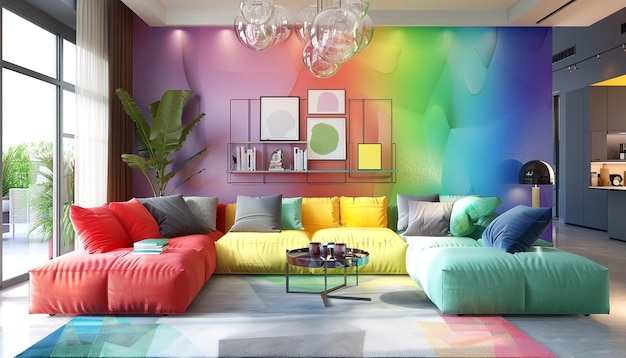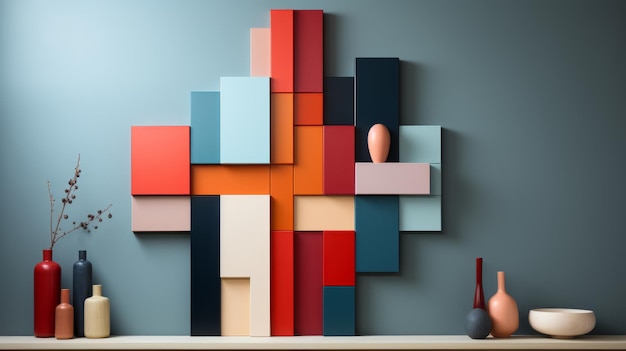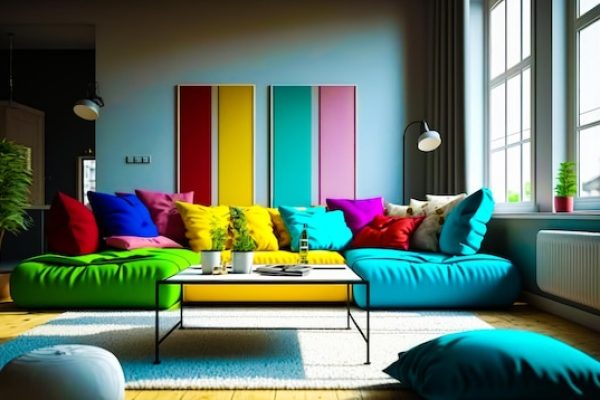Hey there, I’m Emily, and if you’re anything like me, you probably spend hours scrolling through Pinterest, flipping through magazines, or even visiting friends’ houses to find inspiration for your home. However, one thing always gets me is figuring out the right interior design colors for my space. With so many options, deciding on a beautiful, practical palette can be overwhelming. So, if you’re wondering how to choose the right colours that look good and make you feel good in your home, you’ve come to the right place.
In this guide, I’m going to give some insights into choosing the perfect interior design colours for any room in your house. I’ve got you whether you’re painting your walls, picking out furniture, or choosing accent colours. I’ll also answer some common questions and share tips on how you can blend hues to create an atmosphere that reflects your style.
Why Do Interior Design Colours Matter?

Before we dive into colour choices, let’s try to understand why interior design colours are so important. Colours can completely change the feel of a space. They can make a room feel calm and relaxing or vibrant and energising. They can even influence your mood—seriously, colours have that much power!
If you’ve ever entered a room and instantly felt a certain way—whether relaxed or alert—it’s because of the colours used. Think about it: soft blues and greens promote calmness, while reds and oranges can make a space feel dynamic and lively.
So, understanding how to choose the right palette is crucial if you want to create the perfect mood and style for your home.
How Do I Choose the Right Interior Design Colours?
Choosing the right interior design colours for your space doesn’t have to be stressful. Here are some key things to think about:
1. Consider the Size of the Room
If you’re work in a smaller room, lighter colours—like soft whites, light greys, or pastels—can make the space feel bigger and airier. Dark colours, on the other hand, can be perfect for large rooms, adding depth and making the space feel more intimate and cosy.
2. Think About the Lighting
Lighting can completely change the way colours appear. Natural light brings out the best in warm tones, while artificial light can make cooler colours seem colder or more muted. Before committing to a colour, test it out in different lighting conditions to make sure it complements your room’s lightroom.
3. Use the 60-30-10 Rule
This is a classic design rule that helps balance colours in a room. Here’s how there’s:
- 60% of your room should be a dominant colour (usually the walls).
- 30% should be a secondary colour (often furniture).
- 10% should be an accent colour (think throw pillows, rugs, and art).
This Rule ensures your space feels cohesive and well-thought-out without overwhelming your senses with too many colours.
4. Match Colours to Your Personality
Your home is an extension of your identity, so choose colours that reflect your personality. If you love calm, restful spaces, shades of blue or green can bring that peaceful vibe to your bedroom or lounge. If you thrive on energy and creativity, don’t be afraid to go for bold oranges, reds, or yellows in your office or kitchen.
Popular Interior Design Colours for Every Room
Sometimes, it’s easy to get stuck when thinking about what colours work best in specific rooms. Here’s a brewery of some popular colour choices for different spaces:
Living Room
The living room is where you relax, entertain guests, and spend a lot of time, so you want a colour that creates a welcoming environment. Neutral tones, like greys, whites, and beiges, are timeless and work well with most furniture styles. But if you want warmth, add earthy tones like terracotta, sage green, or mustard yellow for accents.
If you’re feeling adventurous, you could use deep navy or charcoal for a dramatic touch. Pair these with lighter furniture and bold art to keep it fresh.
Bedroom
The bedroom should be a sanctuary to unwind and rest well. Soft, muted colours like light grey, soft pink, and pale blue are perfect for creating a relaxing atmosphere. Consider navy oyou’recoal for a cosy, enveloping feeling if you’re into deeper hues.
Kitchen
For kitchens, vibrant colours are often associated with energy and appetites—yellows, oranges, or fresh green. However, if you prefer a more classic look, crisp whites and greys with pops of metallics (like gold or brass accents) can create a sophisticated vibe.
Bathroom
Bathrooms are perfect for experimenting with lighter shades or fresh colours. Soft blues, greens, and whites make a bathroom feel fresh and airy. For a bolder look, you could also try deep navy, teal, or black paired with clean white fixtures.
How to Mix and Match Colours
It’s all goodIt’spick a base colour, but how do you make it work with other shades in the room? Here are a few quick tips for mixing and matching interior design colours:
- Complementary Colours: These are colours that sit opposite each other on the colour wheel, like red and green or blue and orange. Use them in accents to create balance and energy.
- Analogous Colours: These are colours that sit next to each other on the colour wheel, such as blue, teal, and green. They work beautifully together for a harmonious feel.
- Monochromatic Scheme: This involves using different shades and tones of the same colour. It’s a safe, It’sisticated way to design a space without overcomplicating things.
Practical Tips for Choosing Interior Design Colours
Here are some additional tips to help you with your colour selection:
- Start with What You Have: If you’re not from scratch, try picking colours based on your existing furniture or flooring. This way, you can complement what you already own and create a seamless look.
- Test Samples: Always try out colour samples on your walls before committing. Paint a small wall section and observe it in different lighting throughout the day. Colours can look very different under natural light compared to artificial lighting.
- Create Mood Boards: If you’re unsure of how to start, gather inspiration from magazines, websites, or photos you’ve taken. Having a mood board can help you visualise how different colours will come together in your space.
Final Thoughts on

Choosing interior design colours doesn’t have doesn’tomplicated or stressful. It’s about experimenting with colours that make you feel good in your own space. Take your time, trust your instincts, and most importantly, have fun with it!
Whether you’re painting your walls, buying new furniture, or adding finishing touches with décor, the colours you choose can completely transform your home into a place that feels uniquely yours. If you ever remember that less is more—sometimes the simplest colour palettes create the most powerful impact.
What are your favourite colours to use at home? Let me know in the comments, and feel free to share any interior design tips you’ve pickedyou’veong the way! I’d love to hear from you. And if you found this guide helpful, don’t forget to share it with a friend who’s also in who’s of some colour inspiration.
Happy decorating!
o1-mini


